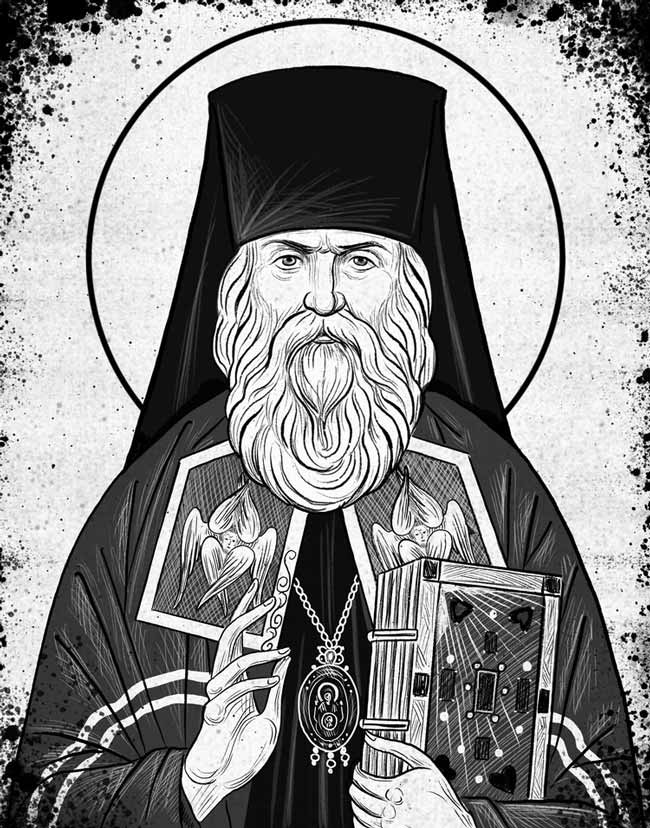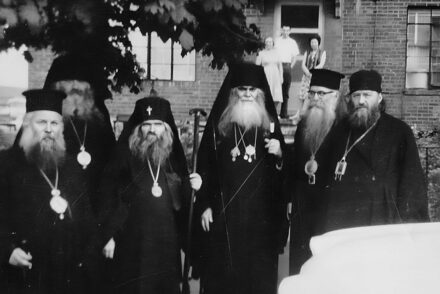Bishop Ignatius, whose baptismal name was Dimitry Alexandrovich Brianchaninov, was born into a distinguished noble family on February 6, 1807, in the village of Pokrovskoye, located in the Griazovets area of Vologda Province. He was the fruit of the ardent prayers of his parents, who had been childless for many years.

Even from his earliest years, the future hierarch displayed a special predisposition to prayer and to ethical and spiritual reading. His favorite book, after the Gospels, was The School of Piety in the five volumes of an old edition, containing brief lives of the saints and selections of their sayings. Following an excellent primary education given him at home by private tutors, in his sixteenth year he was sent to St. Petersburg to the Central Academy of Engineering. But even while on the road there, the future churchman resolved that he tell his father of his covert intention “to go into monasticism,” which his father had not considered worthy of serious thought. Dimitry Alexandrovich distinguished himself as a student and came to the attention of the Emperor Nicholas Pavlovich I and Her Imperial Majesty, the Empress, who received him into the ranks of her pensioners.
While studying military engineering in the school, Dimitry Brianchaninov occupied himself with “noetic” prayer and led the life of a true monk, partaking frequently of the Sacred Mysteries of Christ at the Valaam Conventual House and visiting monks of the St. Alexander Nevsky Lavra, who were remarkable for their spiritual life. As a result he firmly resolved to be tonsured, despite the displeasure of his parents and of the Emperor himself. This decision was furthered by his acquaintance with the future elder of Optina, Hieromonk Leonid. And so in spite of all the obstacles arising from his social position, Dimitry Brianchaninov, although already an oficcer, succeeded in 1827 in receiving a discharge and entered the St. Alexander of Svir Monastery as a novice, where he whole-heartedly devoted himself to the guidance of his elder, the same Father Leonid (Lev in the great schema).
Subsequently, he transferred with Fr. Leonid, first to the Ploschchansky Hermitage and later to Optina. His father, using the illness of his mother as a pretext, tried to lure the future hierarch out of the monastery; illness further tied him for a time to his parental home in Vologda. The local bishop, His Grace Stephen, showed a deep interest in him, tonsuring him with the name Ignatius on the 28th of June 1831 and shortly ordained him. In 1832 he was appointed as the organizer of the Pelshemsky Lopotov Monastery in the Vologda Diocese and in the following year, he was elevated to the rank of abbot. A Synodal decree designated him the superior of the St. Nicholas-Ugreshsky Monastery in the Moscow Diocese, but at the request of the Emperor, he was made head of the St. Sergius Hermitage near St. Petersburg and elevated to the rank of archimandrite (1834). After laboring strenuously for the monastery’s well-being, in 1838 he was made supervisor of all the monasteries in the Diocese of St. Petersburg, and was accorded universal respect and spiritual confidence, first as an administrator, and then as an elder in the religious guidance of the monastics. It was here that he initiated his extremely valuable activities in the field of spiritual literature and began to write his Ascetic Works. Because of illness, he was released in 1847 to the St. Nicholas-Babaevsky Monastery in the Diocese of Kostroma, where he penned spiritually edifying letters to various persons. In 1856 he undertook a trip to Optina, with the aim of arranging a long-sought-for withdrawal to silence and seclusion, but he was required to return to St. Petersburg, where on October 27 of the following year, he was solemnly consecrated in the Kazan Cathedral as Bishop of the Caucasus and the Black Sea, with his cathedral in Stavropol.
Here he labored greatly on behalf of this large diocese, and was especially concerned for the education of youth. It was here that he wrote his famous work, An Offering to Contemporary Monasticism—The Arena. In 1861 he was retired because of ill health to the St. Nicholas-Babaevsky Monastery, where he reposed on April 30, 1867.
The works of Bishop Ignatius were published in Russian in six volumes, the first three being Ascetic Works; Vol. IV: Ascetic Sermons and Letters to Laymen; Vol. V: The Arena; Vol. VI: Patericon.
The great significance of Bishop Ignatius’ works lies in their simple and easily understood presentation, in a contemporary idiom and in a vivid, literary and artistic form, of all the most valuable patristic truths on the spiritual and ethical life of a Christian.
Translated by Timothy Fisher from vol. I of the Ascetic Works (Experiences) by Bishop Ignatius Brianchaninov, Holy Trinity Monastery, Jordanville, 1957, pp. 6–7.

Orthodox Life, Vol. 33, No. 2, March-April, 1983, pp. 47–49





Pas de commentaire